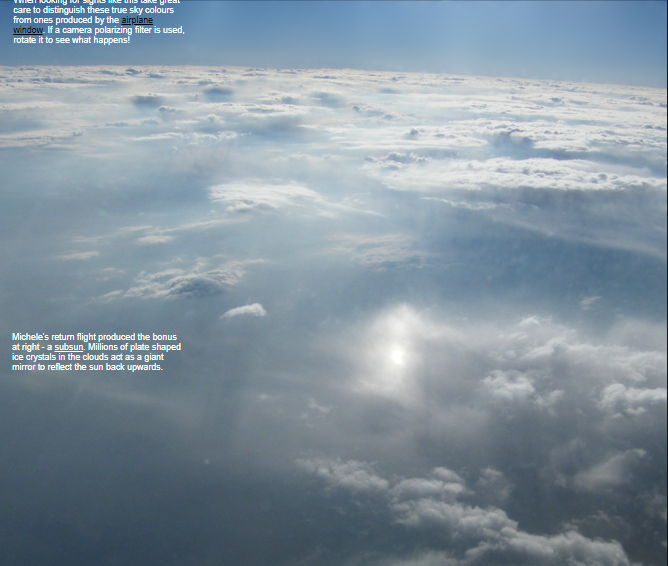Colours & subsun
Colours & Subsun: A Spectacular Atmospheric Phenomenon
When it comes to atmospheric optics, one of the most captivating sights is the iridescent colors in clouds. While these colorful displays are often observed from the ground, there are instances when they can be seen above the clouds, creating a truly rare and remarkable spectacle. This phenomenon, known as above cloud iridescence, occurs when water droplets or ice crystals in a thin streak of stratus diffract light from the low sun, resulting in a stunning array of colors.
To fully appreciate and distinguish these true sky colors from those produced by an airplane window, it is essential to exercise caution. Sometimes, the use of a camera polarizing filter can help in differentiating between the two. By rotating the filter, one can observe how the colors are affected and gain a better understanding of their origin and nature.
However, above cloud iridescence is not the only breathtaking atmospheric optics phenomenon that can occur. On Michele's return flight, she was fortunate enough to witness another stunning sight—a subsun. This extraordinary phenomenon is created by millions of plate-shaped ice crystals present in the clouds, which act as a giant mirror reflecting the sun's rays back upwards.
The subsun, also known as a 22-degree halo or a sun dog, appears as a bright spot directly below the sun. It forms when sunlight passes through these ice crystals and is refracted, causing it to spread out and create a halo-like effect. The subsun is typically located at an angle of 22 degrees from the sun, hence its alternative name. It is an awe-inspiring sight that adds an extra touch of magic to the already mesmerizing world of atmospheric optics.
While the above cloud iridescence and subsun phenomena are undoubtedly captivating, it is important to note that they are not exclusive to these specific conditions. Similar displays can occur in various other atmospheric situations, each with its own unique characteristics and visual appeal. Understanding the underlying science behind these phenomena allows us to appreciate the wonders of nature and the intricate interplay of light and atmospheric particles.
When it comes to observing and photographing these extraordinary atmospheric displays, there are a few key considerations to keep in mind:
-
Location: Certain regions or climates may be more conducive to witnessing these phenomena. Understanding the local weather patterns and cloud formations can increase the chances of capturing these elusive sights.
-
Timing: The time of day plays a crucial role in the visibility and intensity of these phenomena. Morning and evening hours, when the sun is lower in the sky, tend to offer the best conditions for observing and photographing above cloud iridescence and subsuns.
-
Equipment: While these phenomena can be witnessed with the naked eye, having a camera can help capture their true beauty. Additionally, accessories such as polarizing filters can enhance the colors and details, allowing for more striking photographs.
-
Patience and Persistence: Atmospheric optics phenomena are not always predictable, and it may take several attempts to witness and photograph them successfully. Persistence and patience are key virtues for anyone seeking to capture these ethereal moments.
In conclusion, above cloud iridescence and subsuns are just two examples of the captivating atmospheric optics phenomena that grace our skies. These natural spectacles remind us of the beauty and complexity of our atmosphere, showcasing the intricate dance between light and atmospheric particles. By understanding the science behind these phenomena and employing the right techniques, we can immerse ourselves in the enchanting world of atmospheric optics and capture its wonders for all to see. So, keep your eyes on the skies and be prepared to be amazed by the breathtaking displays that nature has in store.

Above Cloud Iridescence ~ Imaged by Michele Plews on the start of a descent into Port Elizabeth, South Africa. ©Michele Plews, shown with permission.
Iridescent colours in clouds are often seen from the ground. This above cloud sight is rarer.
Water droplets (or ice crystals) in a thin streak of stratus are diffracting light from the low sun to produce the colours.
When looking for sights like this take great care to distinguish these true sky colours from ones produced by the airplane window. If a camera polarizing filter is used, rotate it to see what happens!

Michele's return flight produced the bonus at right - a subsun. Millions of plate shaped ice crystals in the clouds act as a giant mirror to reflect the sun back upwards.
Note: this article has been automatically converted from the old site and may not appear as intended. You can find the original article here.
Reference Atmospheric Optics
If you use any of the definitions, information, or data presented on Atmospheric Optics, please copy the link or reference below to properly credit us as the reference source. Thank you!
-
<a href="https://atoptics.co.uk/blog/colours-subsun/">Colours & subsun</a>
-
"Colours & subsun". Atmospheric Optics. Accessed on April 16, 2024. https://atoptics.co.uk/blog/colours-subsun/.
-
"Colours & subsun". Atmospheric Optics, https://atoptics.co.uk/blog/colours-subsun/. Accessed 16 April, 2024
-
Colours & subsun. Atmospheric Optics. Retrieved from https://atoptics.co.uk/blog/colours-subsun/.